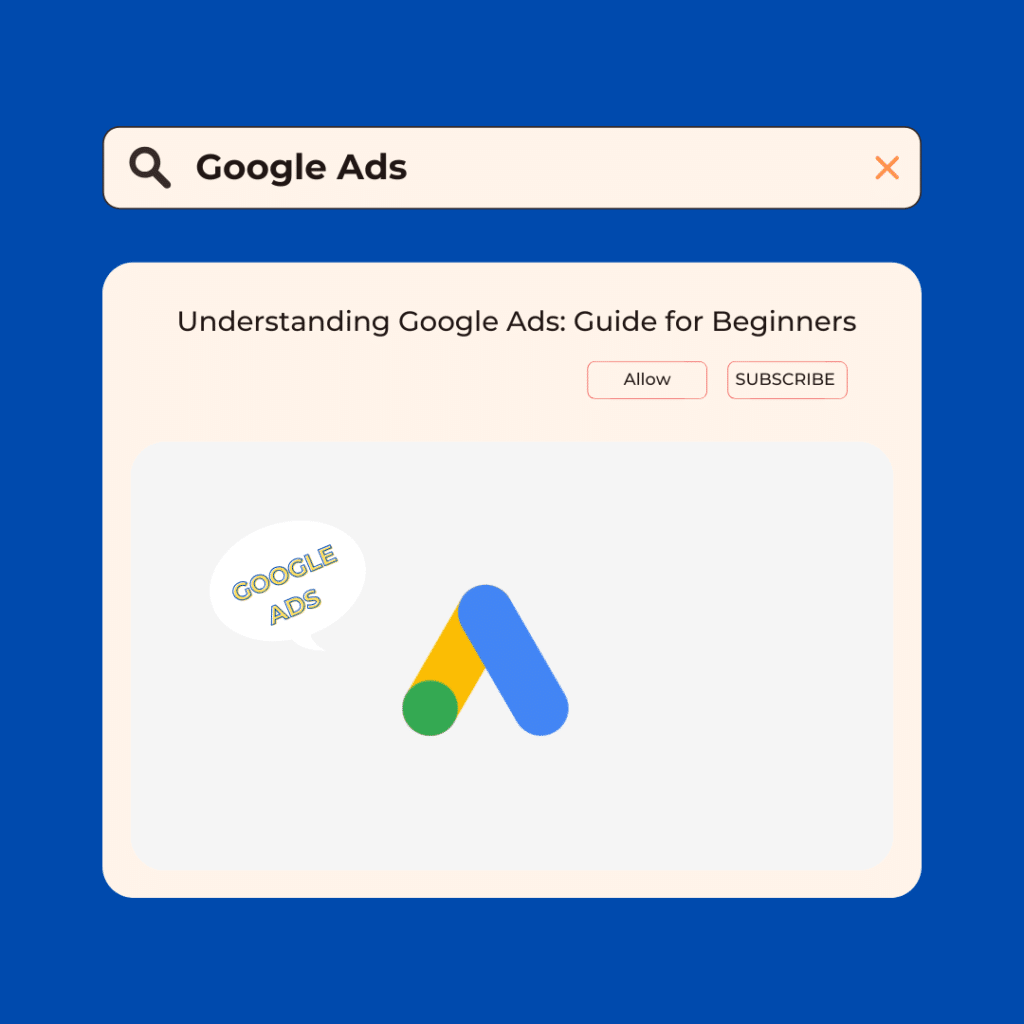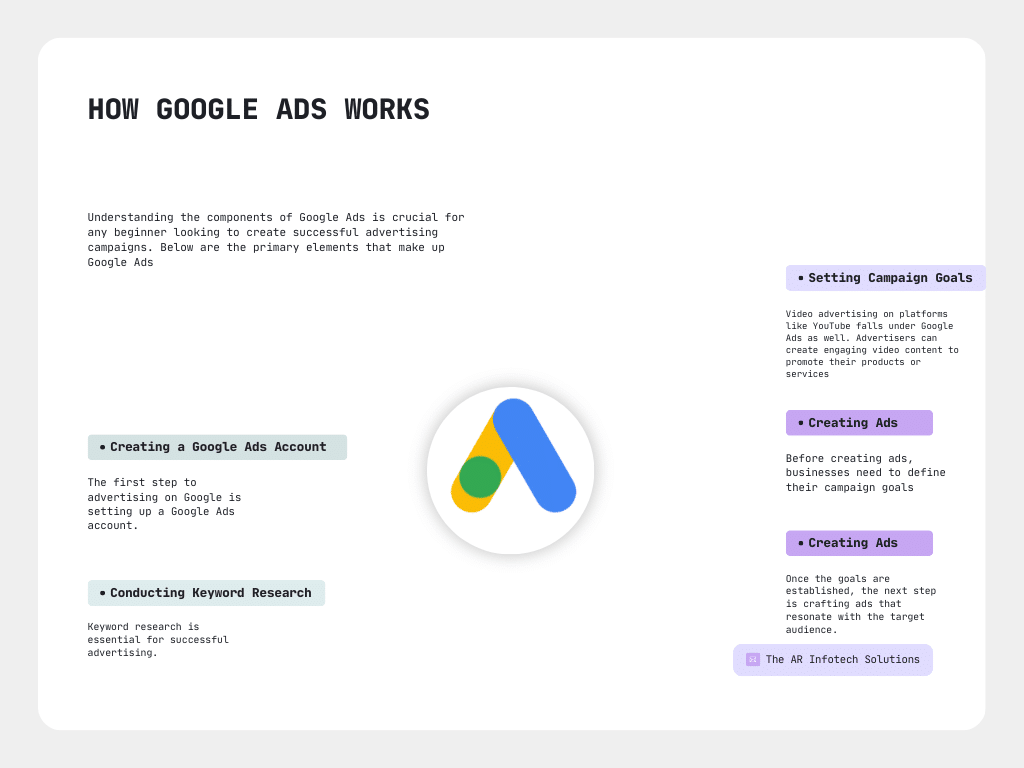In today’s digital age, advertising has transformed dramatically, evolving from traditional methods to advanced online platforms. Among these platforms, Google Ads stands out as one of the most powerful tools for businesses looking to promote their products and services. In this comprehensive guide, we will delve into the essentials of Google Ads, how it works, its various components, and why businesses should leverage this marketing powerhouse to reach their target audiences effectively.
Why Google Ads Still Matters in 2025

Picture this: You grab your phone, search for “best budget smartphone under ₹20,000”, and before you can even blink, Google throws up a neat row of ads right at the top. These ads aren’t random. They’re carefully placed, highly targeted, and in most cases, they get the first click.
That, in essence, is Google Ads — a system so deeply woven into how we browse and shop that it quietly influences millions of decisions every single day.At The AR Infotech Solutions, we’ve seen this play out repeatedly. A café in Delhi that was struggling with weekend footfall? Their tables filled up once we set up a simple local search campaign. A healthcare clinic looking to reach patients beyond word-of-mouth? Ads brought inquiries straight from people searching “dentist near me.” And for e-commerce brands, Google Ads has often meant doubling sales in months, not years.
But here’s the thing: for beginners, the platform feels complex. Too many tabs, too many choices, too many terms. This guide is our attempt to strip it down, step by step, so you can start small and grow confidently without feeling like you’re tossing money into thin air.
What Exactly is Google Ads?
Think of Google Ads as the internet’s most efficient billboard. Unlike a real billboard on a highway — where thousands pass by, but only a handful might care — Google Ads shows up only to people who are actively searching for what you offer.

Formally known as Google AdWords, the platform today lets you promote your business across multiple formats
- Search Ads → Text ads right above Google’s organic results
- Display Network → Banners on blogs, apps, and news sites you browse daily.
- YouTube Ads → Short clips before or during videos.
- Shopping Ads → Product listings with price tags, images, and store names.
- Discovery Ads → Personalized ads on Gmail and Discover feeds.
If people are online, Google has a way to put your brand in their line of sight.
Why Beginners Should Take Google Ads Seriously
Some business owners ask us, “Why not just rely on SEO or Instagram ads?” The answer lies in speed and intent.

- Speed: SEO is slow-burn. It works, but takes months. With Ads, you can get leads tomorrow.
- Intent: Social media shows your ad to casual scrollers. Google Ads appears when someone types “buy organic honey near me.” That’s a buyer, not a browser.
- Control: You choose the spend — whether ₹500/day or ₹50,000/day. No other platform gives this level of flexibility.
- Clarity: Every rupee spent is trackable. You’ll know how many people clicked, how many filled your form, and how much revenue came back
For small businesses, this means you can finally compete with giants without needing their marketing budgets.
Step 1: Creating Your Google Ads Account
The process is simple, but the decisions you make here matter.
- Visit ads.google.com.
- Sign in with your Gmail.
- Click Start Now.
- Choose a goal (sales, leads, traffic).
- Add billing details.
💡 Pro Tip: Before you run your first campaign, spend an hour on Google Skillshop. It’s free, beginner-friendly, and even offers certifications. Many of our interns at AR Infotech started there before handling real campaigns.
Step 2: Picking the Right Campaign Type
This is where most beginners hesitate. Google throws five options at you. Which one should you pick?
- Search Ads → Best for leads.
- Display Ads → Great for awareness.
- Video Ads → Works well for branding, especially on YouTube.
- Shopping Ads → Ideal for e-commerce.
- Performance Max → Google’s AI-driven all-in-one campaign.
👉 If you’re starting: go with Search Ads. They’re easier to track and directly connect to people looking for your service.
Step 3: Keywords – The Real Engine Behind Ads
Your ad only shows when someone searches using words (keywords) you’ve chosen. That’s why this step is crucial.
Example: Running an organic honey store in Delhi? You’d want keywords like:
- buy organic honey online
- pure honey near me
- best honey brand India
Google’s Keyword Planner helps you discover:
- Search volumes.
- Keyword competition.
- Estimated CPC (cost per click).
💡 Golden Rule: Don’t burn money on broad words like “shoes.” Instead, target “men’s running shoes under ₹2000 India”. It’s specific, relevant, and cheaper.
Step 4: Writing Ads That Actually Get Clicked
A good ad copy isn’t Shakespeare. It’s about clarity + relevance + a little push.
Ad Blueprint:
- Headline: Short, keyword-rich, direct.
- Description: Why should they click? Add urgency or an offer.
- URL: Lead to the right page (never dump people on your homepage).
Example:
- Headline: Buy Organic Honey Online | Free Delivery Delhi
- Description: 100% Pure & Natural – Order Today, Save 20%
Step 5: Don’t Waste Clicks – Build Proper Landing Pages
This is where many campaigns fail. Ads bring traffic, but visitors leave if the page doesn’t match expectations.
Checklist for a strong landing page:
- Loads under 3 seconds.
- Mobile-friendly (most clicks come from phones).
- Message matches the ad.
- One clear call-to-action.
- Trust elements like reviews, badges, or testimonials.
At AR Infotech, we once worked with a fashion retailer who was sending paid traffic to their homepage. Bounce rates were sky-high. The fix? A focused landing page with “Shop Summer Dresses Under ₹999.” Sales shot up 40% in two weeks.
Step 6: Budgeting & Bidding
Here’s where beginners overthink. Relax. You don’t need lakhs to start.
- Manual CPC: You decide bids. Maximum control.
- Maximize Clicks: Google tries to get maximum traffic within budget.
- Target CPA: Pay for conversions, not just clicks.
- Target ROAS: Best for revenue-focused campaigns.
💡 Our advice: Begin with Manual CPC or Maximize Clicks. Learn the ropes. Then, when data flows in, shift to Target CPA or ROAS.
Step 7: Tracking – The Difference Between Guessing & Growing
Running ads without tracking conversions is like paying rent without checking if anyone lives in the house.
Set up tracking for:
- Purchases.
- Form fills.
- Calls.
- Newsletter signups.
Metrics that matter:
- CTR (click-through rate).
- CPC (cost per click).
- Conversion rate.
- Quality Score.
- ROAS (return on ad spend).
Common Beginner Mistakes
- Skipping negative keywords. (Selling paid courses? Block “free.”)
- Sending people to a homepage instead of a product/service page.
- Ignoring mobile experience.
- Running only one ad variation. Test at least 2–3.
- Stopping too soon. Ads need2–4 weeks for patterns to emerge.
How Much Do Google Ads Cost?
It depends on competition and industry.
- In India, CPCs range from ₹5 to ₹50.
- Café in Delhi: ₹10/click.
- Law firm: ₹200+/click.
Quality Score plays a role. Better ads = cheaper clicks.
Free Resources to Keep Learning
- Google Skillshop – Official free courses.
- Google Ads Help Center – Step-by-step articles.
- YouTube Tutorials – Walkthroughs by experts.
- Agency Blogs – Case studies from WordStream, HubSpot, and AR Infotech.
FAQs
Q1. Is Google Ads free?
No, it’s pay-per-click. But new accounts often get vouchers.
Q2. How long until I see results?
Clicks are instant. Real conversion patterns need 2–4 weeks.
Q3. Do I need a website?
Yes, unless you’re running call-only or local ads.
Q4. Google Ads vs AdSense?
- Ads = you pay to advertise.
- AdSense = publishers get paid to show ads.
Q5. SEO vs Ads?
SEO builds long-term growth. Ads give instant traffic. Use both for balance.
Q6. Can I manage campaigns myself?
Yes. But if budget/industry is competitive, hiring an expert saves money in the long run.
Final Thoughts – Start Small, Learn Fast
Running Google Ads for the first time feels like learning to drive. So many buttons, so many signals. But after a few weeks, it becomes second nature.Begin small. Run a simple search campaign. Spend ₹500/day. Watch the numbers. Then scale what works.
We’ve seen hesitant business owners evolve into confident advertisers who now invest lakhs every month — because results back it up. That’s the beauty of this platform: it rewards consistency and smart decisions.


